With spring in the air, you have got to try this Easy Hanami Dango recipe. Firm, colorful rice balls that are sweet and chewy, this Japanese treat is a must this season.
If you like Asian desserts, you should try these yummy mochi donuts and sweet ube ice cream.
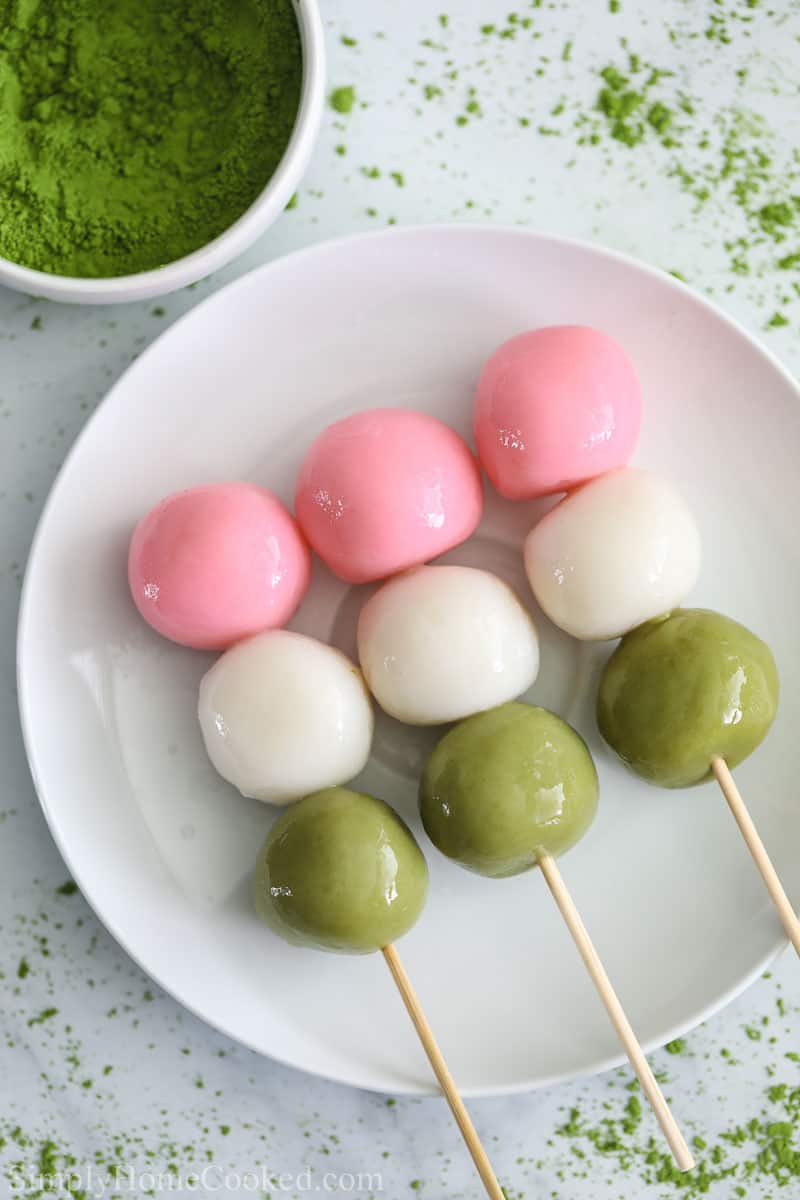
Table Of Contents
Why this Dango recipe is so easy
This Hanami Dango recipe only uses a few ingredients and is really easy to follow. Chewy, tender, but still firm, these rice balls are a sweet treat made with rice flour, and brightly colored with pink food coloring and green matcha powder. This dessert is perfect when paired with some Mochi Donuts (VIDEO) or following a savory meal of Hibachi Fried Rice Recipe or Crispy Shrimp Tempura. Enjoy the sweet pink and white balls, as well as the mildly earthy green ones, in this skewered Japanese treat.
What is hanami dango?
Hanami dango is a year round dessert that is enjoyed most commonly during the cherry blossom viewing season in Japan. This coincides with the beginning of spring, and the three colors are said to symbolize the pink of the spring cherry blossoms, the white of the winter snow, and the green of the summer grass. They are made with sweet rice flour and are bright, chewy, soft, and delicious.
What you’ll need
- Joshinko glutinous rice flour– The Dango base
- Shiratamako glutinous sweet rice flour– The Dango base and also to add sweetness
- Powdered sugar- this is optional but recommended.
- Hot water– This creates the dough to form the dango
- Matcha powder– For flavor and color
- Pink food coloring– For color. Use the gel kind.
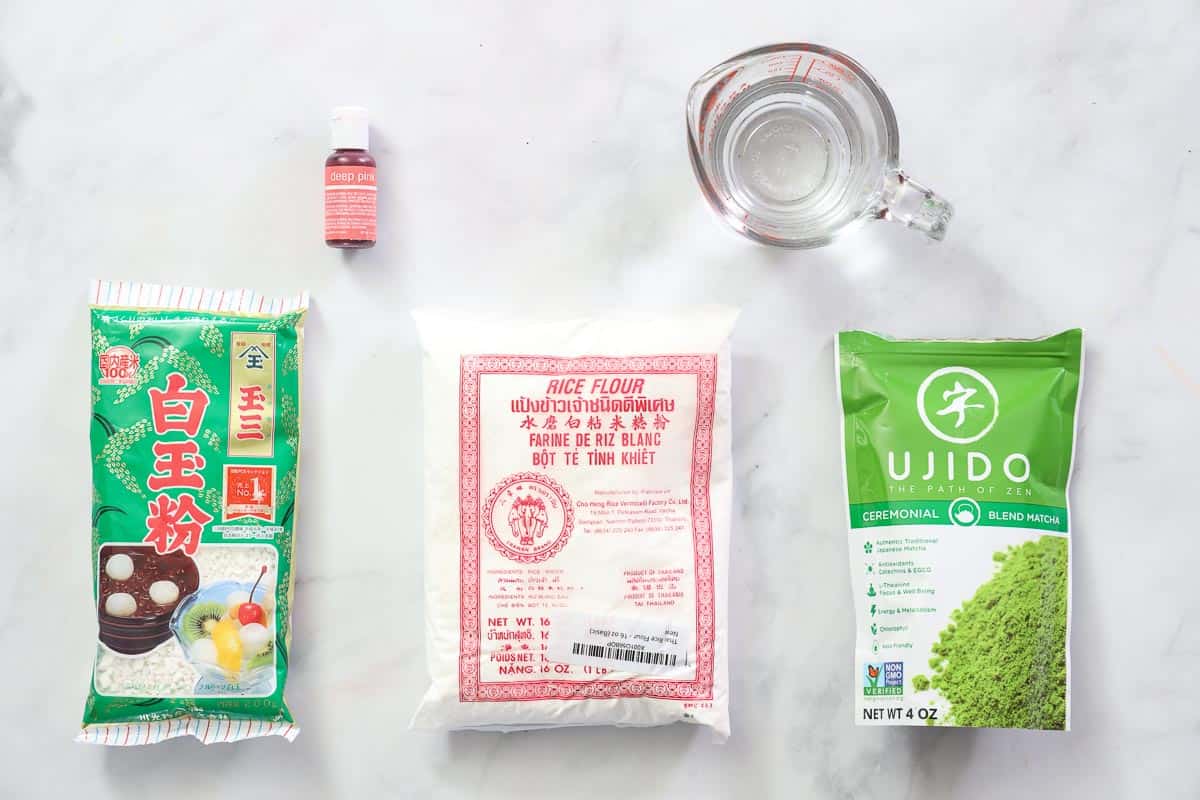
How to Make Hanami Dango
- Soak the skewers. First, soak the 12 bamboo skewers in water.
- Mix the rice flour and water. Place the rice flours into a bowl and then pour in the hot water. Begin mixing with a spoon, and then when it starts to take shape, use your hands to mold the dango dough together. Add a little more flour or water if needed. The dough should feel like clay or play-doh, but softer.
- Divide the dough. Evenly divide the dango dough into three pieces. Place each one into a separate bowl.
- Color the pink dough. Add 1 drop of pink food coloring to one piece of dough and work it in until there is no more white.
- Color the green dough. Now add 1 teaspoon of water to the matcha powder and mix to make a paste. Then add it to another piece of dough and work it in well. The last piece of dough should remain white.
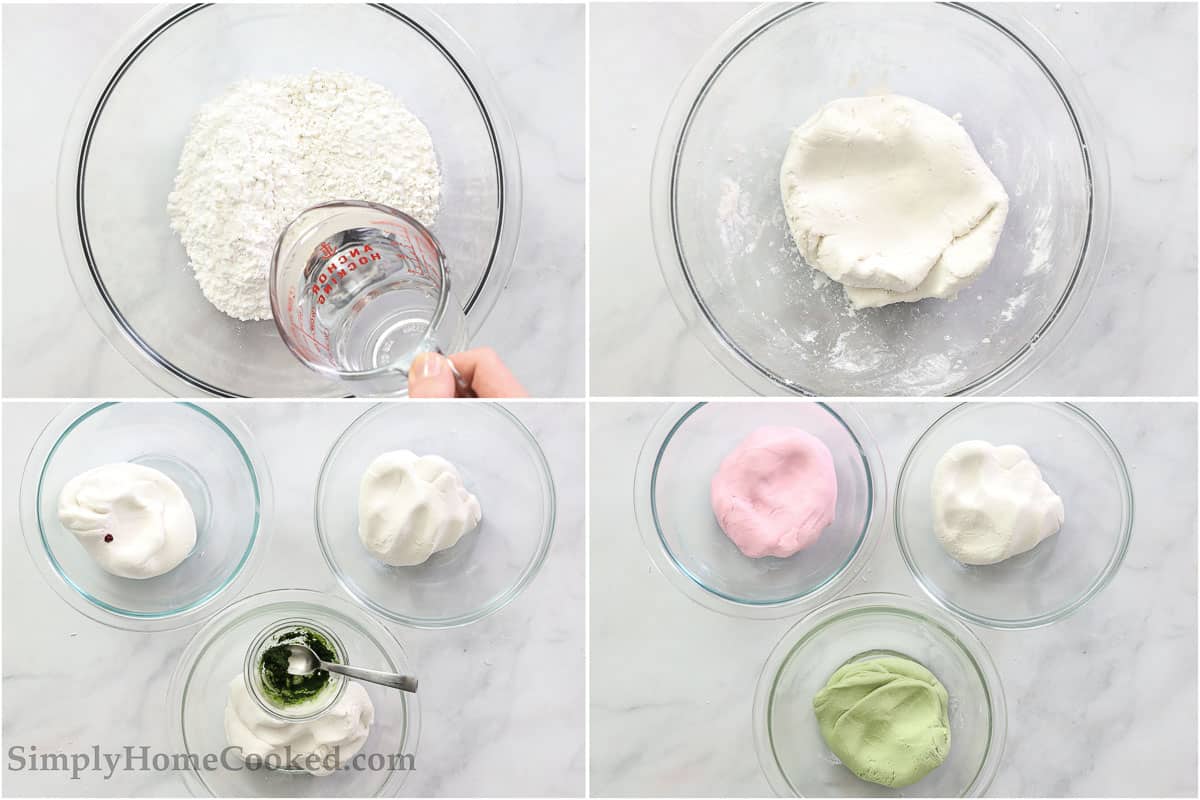
- Shape the dough into balls. Begin shaping the dough into balls. Each ball should be 20 grams, weighed on a kitchen scale. The recipe makes about 36 balls.
- Cook the white dango balls. Bring a pot of water to a boil and begin cooking the white balls first. Once they rise to the top of the pot, continue cooking them for another 2 minutes.

- Cool the dango balls. Once cooked, use a slotted spoon to transfer the steamed dango to a bowl of ice water.
- Repeat with the pink and green balls. Continue this process with the pink and then the green dango to avoid staining the water.
- Skewer the dango. Place the balls on the bamboo skewers, making sure to place the green ones on first, then the white, and the pink ones last. Serve as they are or add a topping.
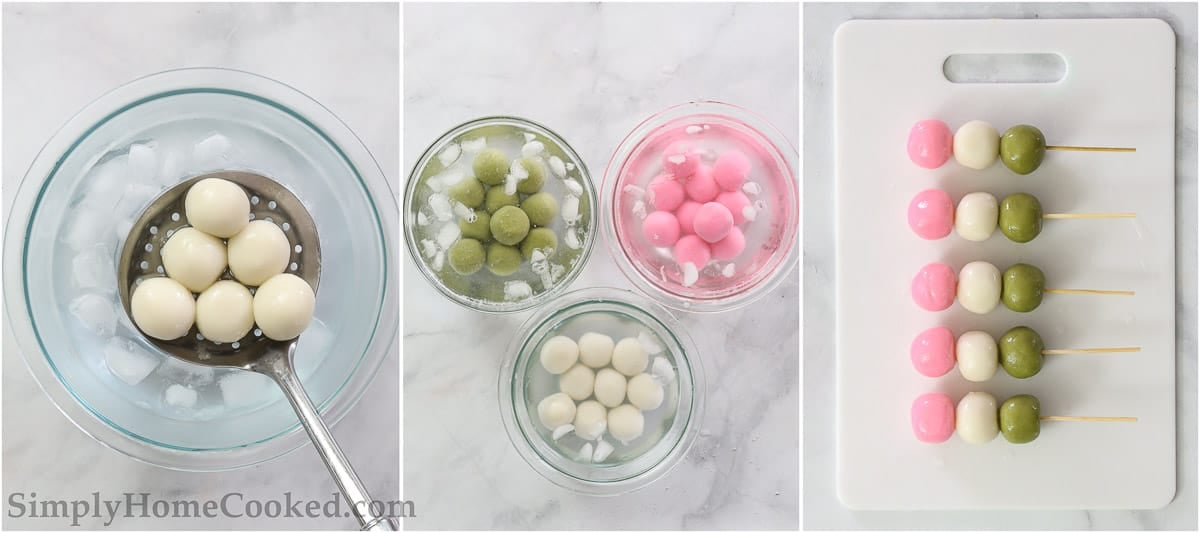
Tips for the best Hanami Dango
- Soak the skewers first– This step is important because it will make it easier to slide the dango balls onto the skewer later.
- Measure with a kitchen scale- For accuracy, measure the flour on a kitchen scale. This will help you get the right texture for your dango dough because it will be more exact. Also, you can measure your dough balls so they are equal in size.
- Soften the dango with tofu- If you prefer a softer texture, you can substitute the water in this recipe with silken tofu. Just make sure the texture remains similar to a soft play-doh.
- Only add one drop of food coloring- The color of the hanami dango will intensify as it cooks, so try not to add more than a drop of pink food coloring or too much matcha, unless you want them to be very, very bright.
- Cook them in the right order– Start with the white, then the pink, and then the green last, lightest to darkest. This is so the colors don’t stain the water and change the color of the dango.

Dango vs. Mochi: What’s the difference
Mochi and dango are not the same. Though they have a similar mild flavor and both are white, their texture is different. Mochi is made with glutinous rice, while dango is made with rice flour. This is an important difference and one cannot be substituted for the other.
Tasty toppings for Dango
These delicious hanami dango can be eaten just as they are, but are also tasty with a topping of sweet soy glaze, red bean paste, or matcha paste. Try each one out to see which you like best!
What to Serve it with
There are tons of delicious dishes that would be perfect before a dessert of hanami dango. You could start with a Shrimp Tempura Roll and Dipping Sauce, or Fried Spring Rolls (VIDEO) with some Yum Yum Sauce. If you prefer soup, this flavorful Shrimp Tempura Udon Soup is wonderful. Also, 30-Minute Shrimp Chow Mein, Grilled Teriyaki Chicken, and Garlic Ginger Shrimp (VIDEO) are great choices. And don’t forget the Ube ice cream!

How to Store Dango
You can store this easy Hanami Dango in an airtight container at room temperature for up to 2 days. A cool place to store it is fine, but avoid the refrigerator because it will make the dango tough.
More tasty Asian dishes to enjoy!
- The BEST Mochi Donuts Recipe (VIDEO)
- Hibachi Fried Rice Recipe
- Ube Ice Cream
- Panko Crusted Salmon
- Shrimp Tempura Roll Recipe
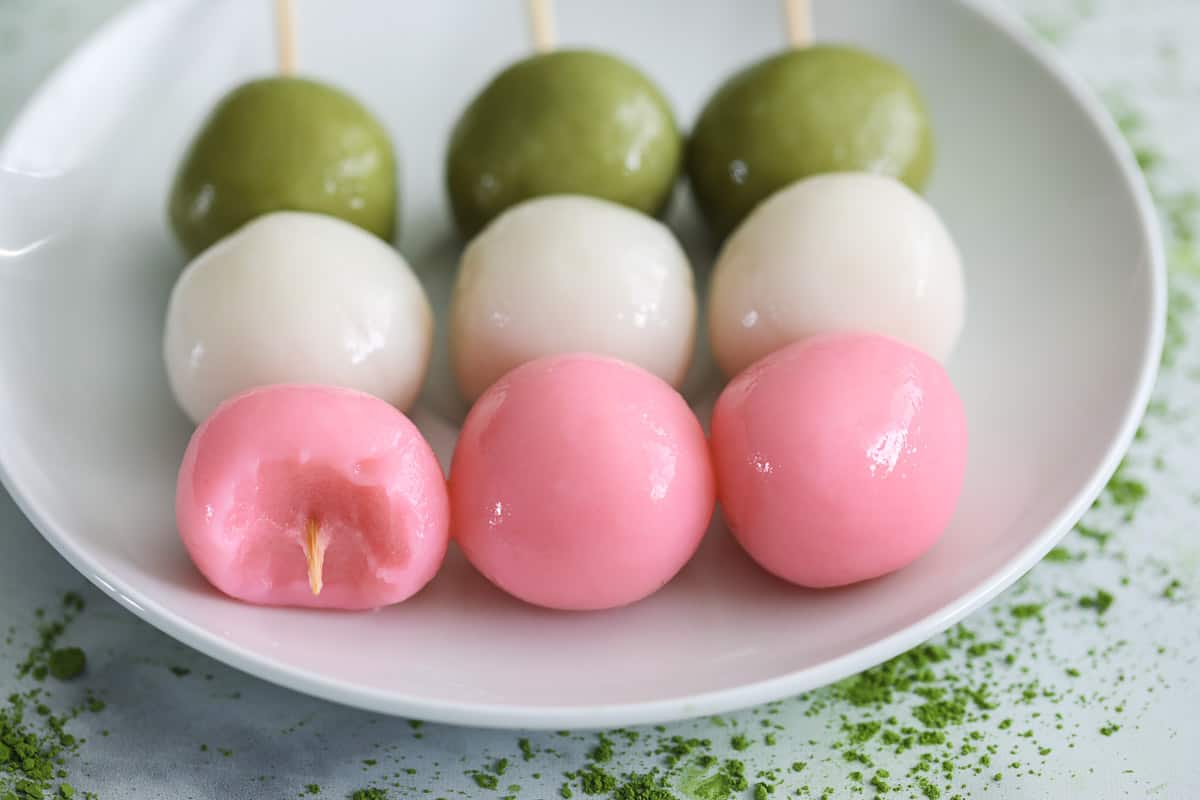
Full Recipe Instructions
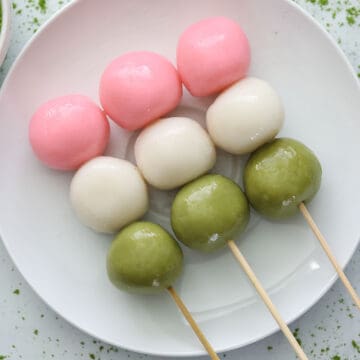
Easy Dango Recipe
Ingredients
- 1 1/3 cup Joshinko non-glutinous rice flour (1 1/3 cup ) 150 g
- 1 1/2 cup shiratamako glutinous sweet rice flour (1 1/2 cup) 200 g
- 3/4 cup powdered sugar (optinal) to make it sweeter 75 g
- 1 1/3 cup hot water
- 1 teaspoon matcha powder + 1 tsp water
- 1 drop pink food coloring
Instructions
- Before you get started on the dango, you’ll need to soak 12 small bamboo skewers in water.
- Add 150 grams of non-glutinous rice flour (joshinko) into a bowl, along with 200 grams glutinous sweet rice flour (shiratamako). You can also add 75 grams of powdered sugar to make the dango sweeter if you want.
- Then pour in 1 1/3 cup hot water. Begin mixing using a spoon. Once the mixture begins to take shape, use your hands to mold the dango dough together. Depending on how you measured your ingredients can determine the texture of the dough. So you may need to add a little more flour or a little more water to get the correct consistency. The dough should feel similar to clay or play-dough, but a little softer.
- Now, evenly divide the dough into three separate pieces. Place the dough pieces into 3 separate bowls. Add 1 drop of pink food coloring into one piece and work it in.
- The second piece of dough will be the matcha one. So you’ll need to add 1 teaspoon of water to 1 teaspoon of match powder to make a paste. Then add the Matcha paste to that dough and work it in as well.
- The third piece of dough will remain white, so you do not need to add anything to it.
- Now shape the dough into round balls. Each ball should be 20 grams. It’s best to use a kitchen scale when measuring out the weight of the dough. This recipe should make about 36 balls.
- Now bring a pot of water to a boil and begin cooking the white dango balls first. Once you see the balls rise to the top of the pot, continue cooking for another 2 minutes.
- Then use a slotted spoon to transfer the steamed dango and quickly place it into a bowl of ice water.
- Continue doing this for the pink dango and then the green dango last. You want to cook in this order to avoid staining the water and changing the color of the dango.
- Now you can skewer the dango onto the bamboo skewers. Always insert the green ones first, then the white ones in the middle, and the pink ones last. The pink symbolizes spring cherry blossoms, white represents winter snow, and green represents summer grass. They are typically eaten during spring cherry blossom season. You can eat them as they are or add toppings like sweet soy glaze, red bean paste, or matcha paste.
Notes
- Soak the skewers first– This step is important because it will make it easier to slide the dango balls onto the skewer later.
- Measure with a kitchen scale- For accuracy, measure the flour on a kitchen scale. This will help you get the right texture for your dango dough because it will be more exact. Also, you can measure your dough balls so they are equal in size.
- Soften the dango with tofu- If you prefer a softer texture, you can substitute the water in this recipe with silken tofu. Just make sure the texture remains similar to a soft play-doh.
- Only add one drop of food coloring- The color of the hanami dango will intensify as it cooks, so try not to add more than a drop of pink food coloring or too much matcha, unless you want them to be very, very bright.
- Cook them in the right order– Start with the white, then the pink, and then the green last, lightest to darkest. This is so the colors don’t stain the water and change the color of the dango.
Nutrition
- Chipotle Chicken Bowl Recipe (VIDEO) - May 4, 2024
- Raspberry Matcha Latte - May 2, 2024
- Bread Dipping Oil - April 29, 2024


Alex Francis says
Hello! I am planning a final meal for my class and I wanted this to be part of my meal. I have a guest whocan’t have any kind of food coloring in their food. Is there another option I could use to color the pink ball?
Dina says
Hi Alex, maybe try strawberry fruit powder as a coloring for the pink balls? I hope that helps 🙂
Jo Ann says
I followed your recipe exactly. Not once but twice. Both times came out delicious and my son wanted more. I had so much fun making them. Directions were so precise and easy to follow. Thank you for even responding to my email when I sent you the pictures. That was awesome. Will definitely be following you.
Dina says
Jo Ann, thank you so much for taking the time to write your kind recipe review! It truly means a lot to me! 🙂
Lori says
Hi,
So the recipe says to use Joshinko non-glutinous rice flour and Shiratamato glutinous sweet rice flour, I thought we are not to use sweet rice flour?
Dina says
Hi Lori, yes you do want to use sweet rice flour. I even have additional sugar as an option. It is quite bland if it’s not sweet enough.
Lilia says
Can I leave them in the fridge for a night to cook them.next day?
Dina says
Hi Lilia, I am not too sure since I have not tried to refrigerate overnight. I am not sure if the texture will change from the cold temperature.
Joji says
Hi – the ingredients say glutinous rice flour, but the directions say non-glutinous?? Not for the sweet rice flour but for the other. Could you clarify please?
Dina says
Hi Joji, I am sorry for the confusion, it should say non-glutinous rice flour in the ingredient list. I just fixed the error. Thank you for bringing that to my attention!
cassandra says
it’s okay it’s nit that good but it is okay
cassandra macadangdang says
it slay so good i love go make it!
SL says
Just tried this for the first time. Worked out great. What a treat!
I used the powdered sugar and split the water as 1/2 water and 1/2 silken tofu that I was able to get at a local Asian Market.
The dango are slightly sweet, soft and chewy. I also made a simple soy syrup with water, sugar, soy and potato starch, to try as a dipping sauce.
All so yummy. Thank you!
Dina says
That’s amazing! Thak you for taking the time to write your kind recipe feedback! 🙂
DJ Hogan says
My granddaughter and I made these. We used rice flour, powdered sugar and followed the rest of recipe. Turned out great, tasted great, fun and easy to make!
Dina says
Happy to hear you and your granddaughter enjoyed this Dango recipe! Glad that those ingredients worked out! Thank you for your feedback and support! I hope you find more recipes to enjoy on my website! 🙂
C says
I have the links confused. How much of the red package and smaller green package do I need for this recipe?
Dina says
Hi 🙂 I have all the ingredient quantities down in the recipe card (bottom of post). If you are referring to the picture then 2 of those packages are different flours and 1 is matcha powder. I hope that helps clarify. 🙂
MUGZCAFE says
It was really sticky and And only ended up only making 7 instead of 12 it tasted good and we had added extra flavor but I wish their was a less sticky way to do this
Dina says
Hmm that’s odd, I never had any issues with them being sticky. Did you use slightly different ingredients than what the recipe called for?
DJ Hogan says
yes mine was sticky too, but I just kept adding rice flour until I got the right feel. Worked great, tasted great, like little sugared rice balls. I wish I could show a picture, but this website doesnt add pics.
Kira says
Same mine didntake as much and i added tons of extra Flour and made them 16oa. I’m waiting for them to float to the top of the water now been boiling for just a couple minutes and they’re looking good!
Kiyomi says
I tried it out and it come out really nicely! The only thing is that it wasn’t as sweet as I thought it would be but I still enjoyed it. It looked really pretty too 😄
Dina says
Hi Kiyomi 🙂 Glad to hear you enjoyed this Dango recipe! Yes, this recipe has a unique flavor and texture to it. It is mild with the sweetness so you can add more as needed. Thank you for your feedback! 🙂
Owen says
When I tried cooking the dango the dango refused to float I need help here
Dina says
Hi Owen, can you explain to me how the floating of the Dango affected the recipe so I can help you. Thanks!
lex says
In my batch, I didn’t have the sweetened rice flour, so I used the glutinous flour for all of it, plus a bit of non-glutinous from the same brand. Then I added a bit extra of the icing sugar, and experimented with using a touch of vanilla extract in the white dango. I also used green color because I couldn’t find matcha powder, and I don’t love the flavor either. My coloring was also liquid, not gel, just working with what I’ve got haha. I did add too much of the green, you can taste a slight slight bitterness to it. The vanilla was not a great move, as it didn’t add anything to the flavor. the pink ones tasted the best, it is definitely an acquired taste, as I saw someone mention in the comments here haha. I’ve seen recipes that use strawberry flavor for the pink, I’d be interested to taste that. This is the second recipe I’ve tried, it was easy to follow and overall I think it’s good. Next time I would try with the sweetened rice flour as well as no vanilla, and making sure the coloring doesn’t slip when I put it in.. oops. But I don’t see any adverse results from not using gel, though perhaps gel would be better yet.
Dina says
Hi Lex, thank you for sharing your experience. I would definitely recommend gel food coloring over the liquid kind. The strawberry flavor addition sounds so good. I need to try that! 🙂
Bella says
Hi, this would be my first time making it, is there any things that are mostly forgotten so I can make sure I don’t forget these steps?
Dina says
If you prefer dango to be sweeter, I recommend adding a little extra sugar. I hope you love them! 🙂
Avia says
I have 2 questions:
*Is the non-glutinous rice flour mandatory? I have only glutinous rice flour. Is there any substitute for the non-glutinous?
*Can I add green food coloring instead of matcha? I don’t really like matcha.
Thank you
Dina says
Hi Avia, I have never tried this without the non-glutenous flour so I can’t say much without testing it out myself. In regards to the food coloring, I have tried using green food coloring and it did not look very pretty. It ended up being a very artificial blue-green color instead of an earthy color from the matcha. Honestly, there is not that much matcha in these so you probably won’t even taste it 🙂
innessa says
can I use different rice flour?
simplyhomecooked says
Hi Innessa, I am not sure since I haven’t tried a different rice flour. If you try it with a different rice flour then let me know how it goes 🙂
Jenny says
Your link says to use joshinko non-glutinous rice flour but the link says the flour is glutinous. Can you please clarify which is correct?
Thanks!
simplyhomecooked says
Hi Jenny 🙂 Thank you for pointing that out to me! I fixed it in the post. It should say glutinous rice flour. Thanks 🙂
Ashley Fletchall says
Hi my grandmother is japanese so I checked with her to make sure and this recipe DOES typically have sugar in it ..
simplyhomecooked says
Hi Ashely, thank you for pointing that out. I just updated the recipe. You can add sugar if you want. I added how much sugar you would need for this recipe. I hope that helps 🙂
Jenny says
Definitely an acquired taste and not as sweet as I thought it would be. However, I had it with sweet soy glaze and that helped. I like that kind of texture but not something most people are used too.
simplyhomecooked says
Hi Jenny, yes this dango recipe is a unique recipe and a aquired taste. Glad that you gave this recipe a try 🙂